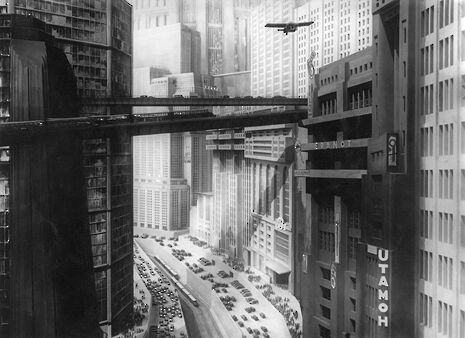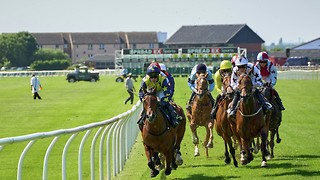VisCourse: Film and the meaning of ‘Metropolis’
Lydia Sabatini examines how the city landscape has evolved into its own signifier in cinematic literature…

The dictionary definition of metropolis is “large city”. Yet the word evokes a much more specific type of cityscape: a technology-powered world of Babel-like skyscrapers and bright, artificial lights. The concept started off as an imagined future, a piece of science fiction, but these types of cities have now become a lived reality for millions.
Fascinatingly, film has been able to document this progression. Rather than a backdrop for speculative social commentary, in contemporary cinema they have become synonymous with individual feelings of disconnect, loneliness and alienation. Filmmakers use many different landscapes to represent the indifferent universe, from desert to tundra. Nonetheless, when Nature is revealed as uncaring and oblivious, it is surely always less disturbing and less tragic when human beings and human society demonstrate that same monumental indifference.
“For a modern viewer the ideologically conservative and ‘fire and brimstone’ Biblical elements may sit somewhat strangely in such a purportedly futuristic film”
One film in particular has been key in shaping our image of what a metropolis is. That is, of course, Fritz Lang’s 1927 silent film of that name, whose imagery feels familiar even to those who have never watched it. Imagery from the movie been hugely influential in sci-fi and fantasy films down the ages, from Star Wars to Superman. But more interestingly, the feeling of moving around imposingly huge, almost fantastical cities is something we may have experienced in real life. While this film is impressively operatic and expressionistic, for a modern viewer the ideologically conservative and ‘fire and brimstone’ Biblical elements may sit somewhat strangely in such a purportedly futuristic film. Yet the fears expressed about the dehumanising effects of technology and mechanisation can still be found in films today, set not in dystopian metropolises but in some of the biggest and most famous cities of our world.
More recent films use the setting of a modern-day metropolis in a way more fitting for character dramas: as a backdrop to explore the alienating nature of city life. In Wong Kar-Wai’s 1994 Chungking Express, the hand-held, kinetic cinematography shows a Hong Kong that rushes by in blurs of colour. While not exactly machine-like, the city certainly seems to move of its own accord. Airplanes are a recurring motif, emphasising the never-ending motion of city life. Every person has their own story, but everybody moves by too quickly to truly connect their stories together. In one striking shot we see Faye Wong staring at the man she is obsessed with. He looks away into the distance, oblivious and utterly self-involved. And between these characters and the camera a teeming, anonymous of mass of humanity rushes to and fro.
“Rather than a backdrop for speculative social commentary, in contemporary cinema they have become synonymous with individual feelings of disconnect, loneliness and alienation”
The modern-day metropolis can feel a particularly alien place if it involves being far away from home. Sofia Coppola’s 2003 Lost in Translation foregrounds the ‘otherness’ of Japanese culture to the Americans staying there. While the pervasive atmosphere of unfamiliarity adds to the sense of lives cast adrift, the playing of many of the Japanese people for laughs is a lot less successful, to say the least.
A more interesting take on the alien metropolis occurs in Wong Kar-Wai’s 1997 Happy Together. Distance, rather than difference, is the focus. The film concerns a couple from Hong Kong living indefinitely in Buenos Aires, because they have no money to return home. Despite the presence of tango bars and the shots of the gleaming Plaza de Mayo, the specific setting is almost incidental. Viewed from the bottom up, working in low-paid immigrant jobs, most metropolises look the same. The result of this is a profound loneliness and homesickness, leaving characters clinging to the familiar even when the familiar is damaging. The strange melancholy of being on the literal other side of the world to your home is illustrated by a sequence of shots of Hong Kong shown upside down, as the protagonist muses on the hemispherical space between where he is and where he wants to be.
On the other hand, the effects of the metropolis can be such that even physical touch cannot bridge the space between people, an idea beautifully explored in Hirokazu Koreeda’s 2009 Air Doll. The story is of a blow-up sex doll that comes to life, but what ensues is treated with a subtly and poignancy that is typical of Koreeda’s films. The gleaming lights of Tokyo surround, but this is a muted world where workers eat their lunch alone on park benches, and a polythene air doll seems a reasonable substitute for a flesh-and-blood human relationship. Although a much more delicate kind of fantasy than Metropolis, both films nevertheless offer an exploration of gender identity via an incarnated female object created by a man for men’s pleasure. Yet the focus on the individual misery this causes, rather than the speculative spectacle of metropolis, is what makes Air Doll and its contemporary cousins really involving
 News / East West Rail proposes new Cambridge East station26 November 2025
News / East West Rail proposes new Cambridge East station26 November 2025 News / News in Brief: Cat-astrophic climbs, concealed collections, and Christmas festivities25 November 2025
News / News in Brief: Cat-astrophic climbs, concealed collections, and Christmas festivities25 November 2025 Comment / Don’t get lost in the Bermuda Triangle of job hunting 24 November 2025
Comment / Don’t get lost in the Bermuda Triangle of job hunting 24 November 2025 Features / Why are we so obsessed with getting more done?26 November 2025
Features / Why are we so obsessed with getting more done?26 November 2025 Theatre / How to plan an American stage tour 25 November 2025
Theatre / How to plan an American stage tour 25 November 2025









